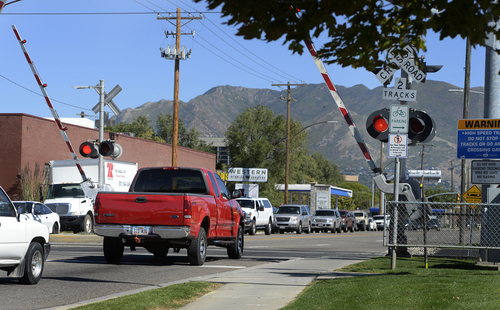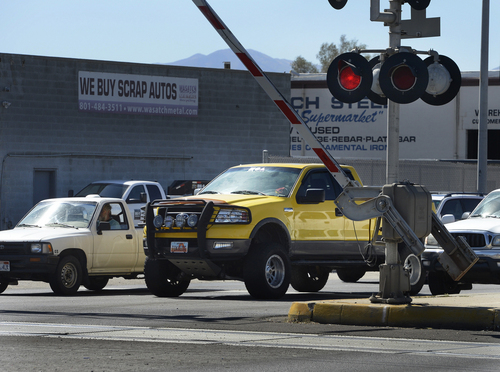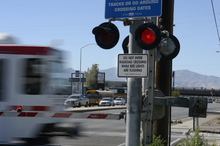This is an archived article that was published on sltrib.com in 2014, and information in the article may be outdated. It is provided only for personal research purposes and may not be reprinted.
Here's a quiz: Is it legal to drive through a rail crossing once the warning gates start rising?
Actually, it's not.
Drivers are supposed to wait until the flashing red lights stop, even if the gates are fully raised.
That's because sometimes a second train from the opposite direction can retrigger signals. Cars that don't wait for the flashing to stop may find that partially raised gates quickly reverse and lower on their car. Worse, motorists could crash into that second train. This isn't a hypothetical situation.
Ignoring that law contributed to 246 broken crossing gates last year along the Utah Transit Authority's TRAX and FrontRunner rail lines. Repairs added up to nearly $250,000, or about the cost of operating one bus route for an entire year.
UTA has been waging an education campaign — including ticketing hundreds of offenders and placing signs explaining the law at crossings and on UTA vehicles. But David Goeres, UTA's chief safety officer, says the "vast majority of people" still take off as soon as gates start to rise.
He notices that when he personally waits for red lights to stop as gates rise, eager drivers behind him often honk, "and wave at me with as many fingers as they want," often a solo middle digit.
"I have stepped out twice in the past year," he says, pointing to a magnetic sign on the back of his car: "Do Not Enter Railroad Crossing While Red Lights Are Flashing, Utah Code 41-6A-1203."
He said drivers are honking at him a bit less lately, and he credits education efforts by UTA, which includes some enforcement surges.
In the past year, UTA Police issued 462 citations, 133 written warnings and distributed hundreds more cards explaining the law to offenders, according to Goeres. Fines vary depending on the city where violations occur, but range from $100 to $300.
The law treats the offense "like running a red light," Goeres says. He adds that while people obviously dislike tickets, it acts as a deterrent and perhaps saves lives. "Pretty much everyone we stop with the police and cite will all say, 'I didn't know that is the rule.' Well, that is the law," Goeres says. "It is the red lights that control. The gate arms are merely a second device to provide a secondary warning and provide some kind of physical barrier."
Violators also can expect UTA to sue if they break a gate. In the past 18 months, UTA has recovered about $85,000 from 28 drivers.
Goeres says cars tend to break gates in three ways.
"The majority of complaints we get is, 'Hey, the gate came down on top of my car,' " he says. That's because a second train in an opposite direction retriggered signals. "If the gate comes down on your car, it's your fault."
Another major problem is motorists "leave too early and catch the gate as it goes up. They forget they have something on top of the car, or they are driving a big truck. The gate doesn't clear the car until it is almost vertical," Goeres says.
Finally, some drivers are distracted — and even run into gates that have been lowered and flashing for some time, and have hit trains.
Goeres says through August, UTA had 164 gates broken this year and is on track to reach last year's mark. Because the number of crossings has doubled during the past few years with new rail lines, he believes some progress is being made.
For the record, the crossings with the highest number of broken gates are 500 South in Bountiful on FrontRunner, and TRAX crossings at 1300 South, 2100 South and 3300 South on the main line, plus a crossing at 4000 West on the Mid-Jordan extension of the red line, according to Goeres.
He says better understanding of the timing of gates may encourage more patience by motorists.
When a crossing is activated by an approaching train, the red lights will flash for three to five seconds in an initial warning, similar to a yellow light at a roadway intersection. After that, the gates start moving and take about eight seconds to fully descend. By federal regulation, warning signals must be active a minimum of 20 seconds before the train reaches the crossing.
Goeres addressed his concerns in a "safety minute" at the beginning of a recent UTA meeting.
"Do not drive your bike in front of a moving train. Do not walk down the railroad tracks instead of down the platform at a station. Do not cross the railroad tracks and the road except at a crossing," he said. "Just be safe around transit."







